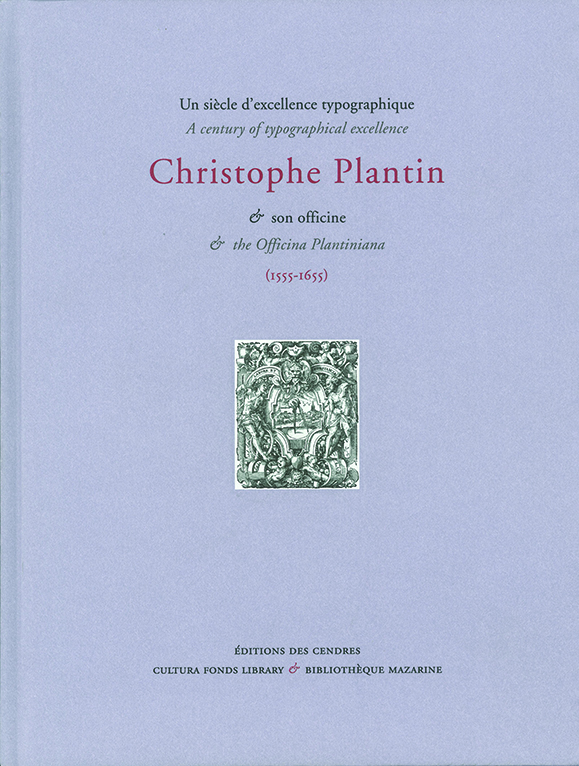Un siècle d’excellence typographique : Christophe Plantin & son officine (1555-1655) / A Century of Typographical Excellence: Christophe Plantin and the Officina Plantiniana (1555-1655).
Un siècle d’excellence typographique : Christophe Plantin & son officine (1555-1655) /
A Century of Typographical Excellence: Christophe Plantin and the Officina Plantiniana (1555-1655).
504 p. | 205 x 265 | relié | gaufrage | 150 illustrations couleurs | 978-2-86742-299-7 | 48 €
Edition bilingue français / anglais
Coédition Bibliothèque Mazarine, Cultura Fonds Library & Editions des Cendres, sortie en mars 2021.
Le premier siècle d’activité de la maison Plantin-Moretus, particulièrement brillant, ses stratégies éditoriales et les exigences de sa production sont au cœur de cet ouvrage. Il montre comment Christophe Plantin et ses successeurs ont transformé́ l’esthétique du livre de la Renaissance et inauguré l’è̀re baroque de la mise en page, en mobilisant un matériel typographique et ornemental nouveau, en promouvant la gravure sur cuivre, en sollicitant de manière privilégiée le peintre Pierre Paul Rubens ou des illustrateurs et graveurs de talent (Pieter van der Borcht, les frè̀res Wierix, Charles de Mallery ou Cornelis Galle).
Native of Touraine, trained in bookbinding, he settled about 1549 in Antwerp, which was already a major hub of international commerce. In 1555, he established the foundations of the largest printing company known during the Ancien Régime in Europe.
Business genius and talented typographer, Plantin gained an official position with his nomination in 1570 as architypographer of Philip II, king of Spain, who reigned over the whole of the Low Countries at this time. His officina, which took as emblem ‘The Golden Compasses’, became one of the most important editorial supporters of the Counter-Reformation, though this did not prevent him from engaging in clandestine activities. At his death, it passed to his son-in-law Jan Moretus I and remained in family hands until the 19th century.
From the beginning, Plantin’s production was distinguished by its elegant style. His correspondence, part of the exceptionally well-preserved archives of the business, testify to his ample commercial ambitions and great attention shown to the expectations of the public and the market. They also document an utmost care given to the conception of books.
The first century of activity of the Plantin-Moretus printing-house, which was especially brilliant, its editorial strategies and the requirements for its production are at the heart of this exhibition. It shows how Christophe Plantin and his successors transformed the aesthetic of the Renaissance book and launched the Baroque era of the page layout in marshalling typographic and novel decorative materials, in promoting illustration with copper engravings, in appealing in a favourable manner to the painter Peter Paul Rubens or talented illustrators and engravers (Pieter van der Borcht and the Wierix Brothers, Charles de Mallery or Cornelis Galle). In this golden century, the Plantinian printing-office published more than 5,000 editions, combining visual allure with legibility and efficacy.
Table des matières
Préface : Efficacité et séduction typographique : le premier siècle
de l’officine plantinienne, Goran Proot & Yann Sordet
Christophe Plantin : parcours d’un grand entrepreneur
du livre dans l’Europe de la Renaissance, Christophe Vellet
L’ Officina Plantiniana de la « Renaissance » à l’âge « baroque » :
une transition typographique (1555-1670), Goran Proot
D’Arnold Nicolai à Pierre Paul Rubens : l’illustration du livre
chez Plantin et les premiers Moretus, Dirk Imhof
Les enjeux économiques du choix du format et du papier
dans la politique éditoriale de Christophe Plantin (1555-1589),
Renaud Milazzo
Catalogue
